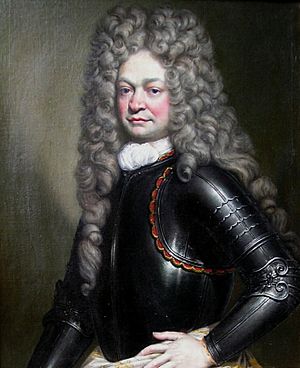Count Claude Florimond de Mercy facts for kids
Quick facts for kids
Claudius Florimund de Mercy
|
|
|---|---|

Anonymous contemporary portrait
|
|
| Born | 1666 Longwy, Duchy of Lorraine |
| Died | 29 June 1734 Parma, Duchy of Parma |
| Allegiance | |
| Service/ |
Imperial Army |
| Years of service | 1682–1734 |
| Rank | Generalfeldmarschall |
| Battles/wars | Great Turkish War
|
Count Claudius Florimund de Mercy (1666 – 29 June 1734) was an important military leader. He was a field marshal for the Holy Roman Empire. He was born in Longwy, which was then part of Lorraine. Today, Longwy is in France.
Mercy was known for his bravery and leadership. He fought in many major wars of his time. These included the Great Turkish War and the War of the Spanish Succession. He also helped govern a region called the Banat.
Contents
Early Military Career
Claudius Florimund de Mercy joined the Austrian army in 1682. He was a volunteer at first. He earned his first officer rank after the big Battle of Vienna in 1683. This battle was a major victory against the Ottoman Empire.
Over the next seven years, he fought in Hungary. He rose through the ranks to become a Rittmeister, a cavalry captain. During this time, he was injured. This injury affected his eyesight for the rest of his life.
After Hungary, he spent five years fighting in Italy. In 1697, Prince Eugene of Savoy called him back to Hungary. There, Mercy fought in the Battle of Zenta. His brave actions in this battle helped him get promoted two ranks at once.
Wars and Promotions
War of the Spanish Succession
Mercy showed great courage during the early parts of the Spanish Succession War in Italy. He was captured by the enemy twice during close-quarters fighting. For his actions at the surprise attack on Cremona in 1702, he was praised by Leopold I, Holy Roman Emperor. He was also given command of a new cuirassier (heavy cavalry) regiment.
With his new regiment, he fought in the Rhine campaign of 1703. He also took part in the Battle of Friedlingen. Mercy became famous for leading daring raids and attacks. Both his friends and enemies knew him as a fearless leader.
In 1704, he was chosen to attack the lands of Maximilian II Emanuel, Elector of Bavaria. Soon after, he was promoted to Generalfeldwachtmeister. In this role, he fought in the Battle of Schellenberg in July 1704.
Later Campaigns
Throughout the rest of the Spanish Succession War, Mercy continued to show great bravery. Over ten years, he became a general of cavalry. His strong leadership was very clear at the Battle of Peterwardein in 1716. Soon after, he was made commander of the Banat region of Temesvar.
At the important Battle of Belgrade in 1717, he led a powerful cavalry charge. This charge helped defeat the forces of the Ottoman Empire. It forced them to retreat to their trenches.
Governor of Banat
After the war, Mercy returned to govern the Banat region. This area had been under Turkish rule for over 150 years. It needed a skilled leader to rebuild it. Mercy worked to make the Banat a successful and well-organized community.
However, his work was interrupted. He was called back to lead troops in southern Italy. There, he fought in the Battle of Francavilla in 1719. He also captured Messina and besieged Palermo.
For another eleven years, he continued to govern the Banat. He successfully reorganized the region. It became a thriving and civilized place.
Final Years and Legacy
In 1733, Claudius Florimund de Mercy was promoted to general field marshal. In the spring of that year, he gathered 50,000 soldiers at Mantua. Their goal was to reclaim lands in Italy that the Austrians had lost.
Mercy was killed on June 29, 1734, at the Battle of Parma. He was personally leading his troops when he died. He did not have any children. His name was passed to Count Argenteau, which led to the Mercy-Argenteau family. He was also the foster father of Florimund Count de Mercy d'Argenteau.
On August 3, 2009, a statue of Count Mercy was put up in Central Park, Timișoara.
See also
 In Spanish: Claude Florimond de Mercy para niños
In Spanish: Claude Florimond de Mercy para niños

